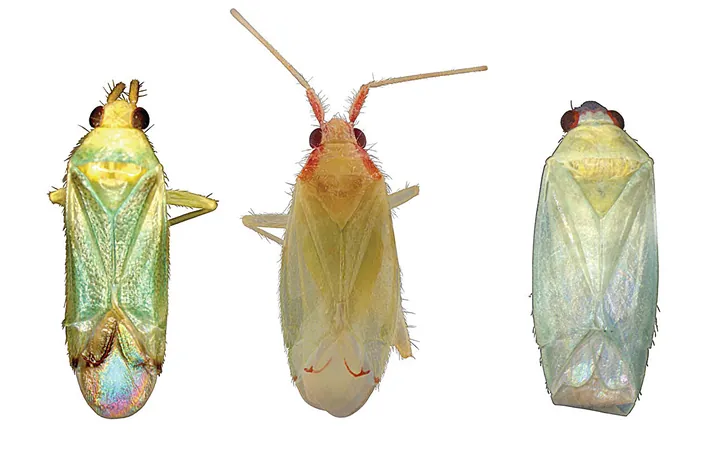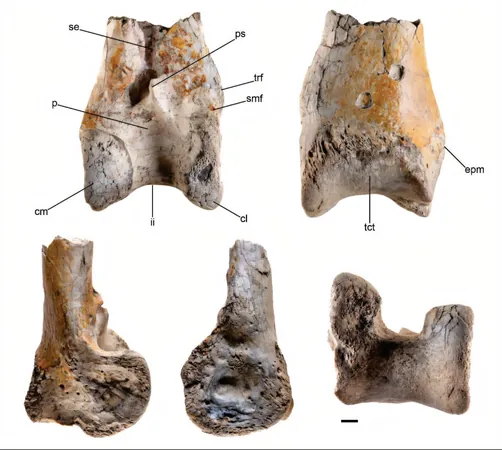
17 Newly Discovered Plant Bug Species in French Polynesia: A Leap for Biodiversity and Education!
2024-11-05
Author: William
Seventeen New Plant Bug Species
Seventeen exciting new species of plant bugs have been discovered in the enchanting archipelago of French Polynesia. These unique insects, boasting a strawlike mouthpart to feed on both plants and animal matter, have been aptly named in honor of notable figures including esteemed scientists, actors, and even Vice President Kamala Harris!
Research Undertaken by Brad Balukjian, Ph.D.
The groundbreaking research was spearheaded by Brad Balukjian, Ph.D., an environmental scientist who dedicated years to field investigations on the islands of Mo'orea, Tahiti, and surrounding isles between 2007 and 2011 for his Ph.D. Thesis. His comprehensive findings, recently published in the esteemed journal, Insect Systematics and Diversity, also challenge outdated taxonomic classifications that relied heavily on insect morphology alone.
Transforming into a Taxonomist
"I realized that the path to understanding the evolution of these bugs began with a detailed identification of what they are," Balukjian noted. This realization transformed him into an unexpected taxonomist, placing the emphasis of his research on elucidating the complex diversity of plant bugs.
Balukjian's Ongoing Passion for Entomology
Even after earning his Ph.D., Balukjian’s passion for entomology has only flourished. He’s not just focused on plant bugs; he also published insightful books on topics as diverse as baseball and wrestling and founded the Natural History and Sustainability program at Merritt College in Oakland, California.
The Manumanu Project
With an aim to bridge biodiversity education, he is kicking off the innovative Manumanu Project in French Polynesia, a collaboration with UC Berkeley's Gump Station and the non-profit group Te Pu Atitia. This endeavor aims to inspire fifth-graders by teaching them about insects, encouraging the protection of their local biodiversity.
Research Focus on Miridae Family
During his research, Balukjian was specifically drawn to a subgroup of true bugs known as the Miridae family, particularly those belonging to the Pseudoloxops genus, sometimes called "green flash bugs" due to their brilliant emerald sheen. Eager to resolve the mysteries surrounding them, he sought to determine their true classifications—an endeavor that had not been undertaken for over a century.
Innovative DNA Sequencing Technology
Utilizing advanced DNA sequencing technology, Balukjian’s integrated approach allowed him to examine the genetic makeup of these insects alongside traditional morphological characteristics. This innovative method revealed an astounding 17 new species and confirmed three previously identified species, while merging three others into a single species, showcasing the importance of modern science in taxonomy.
Community Involvement in Naming Species
Balukjian’s thoughtful naming convention for the new species was intimately tied to the community where he conducted his research. Partnering with local students who aided in specimen collection, he engaged them in the naming process, allowing them to select traditional Tahitian names. He also honored influential figures including the botanist Rava Taputuarai and actor-conservationist Harrison Ford—recognizing Ford’s advocacy work in conservation—by naming new species after them. In a unique perspective, he also named a species after Vice President Kamala Harris, highlighting her efforts in environmental training and her local Oakland roots.
Educational Impact of the Manumanu Project
His innovative approach doesn’t stop at naming species; he's committed to creating a lasting educational impact in French Polynesia. The new Manumanu Project will roll out a hands-on curriculum guiding fifth graders through the colorful world of insects. This program, particularly important in a region where ecological awareness can shape conservation efforts, will teach students to identify various insect orders, collect specimens, and proudly showcase their findings at a local science fair.
A Four-Week Structured Program
The structured four-week program is meant to provide educational, field experience, and enhance students’ fascination with their native ecosystems. Following initial implementation, the curriculum will be made available to teachers for continued use, thus fostering a sustainable educational framework that can endure beyond Balukjian’s presence.
Future Prospects for Biodiversity Education
If this ambitious initiative thrives, future students will not only deepen their understanding of biodiversity but also contribute to long-term data collection, providing valuable insights on insect populations over a span of years, enhancing not only academic knowledge but also community engagement in ecological conservation efforts in the stunning landscapes of French Polynesia.
Conclusion
This incredible fusion of science, education, and community involvement paves the way for a bright future in understanding and protecting biodiversity—one bug at a time!









 Brasil (PT)
Brasil (PT)
 Canada (EN)
Canada (EN)
 Chile (ES)
Chile (ES)
 España (ES)
España (ES)
 France (FR)
France (FR)
 Hong Kong (EN)
Hong Kong (EN)
 Italia (IT)
Italia (IT)
 日本 (JA)
日本 (JA)
 Magyarország (HU)
Magyarország (HU)
 Norge (NO)
Norge (NO)
 Polska (PL)
Polska (PL)
 Schweiz (DE)
Schweiz (DE)
 Singapore (EN)
Singapore (EN)
 Sverige (SV)
Sverige (SV)
 Suomi (FI)
Suomi (FI)
 Türkiye (TR)
Türkiye (TR)